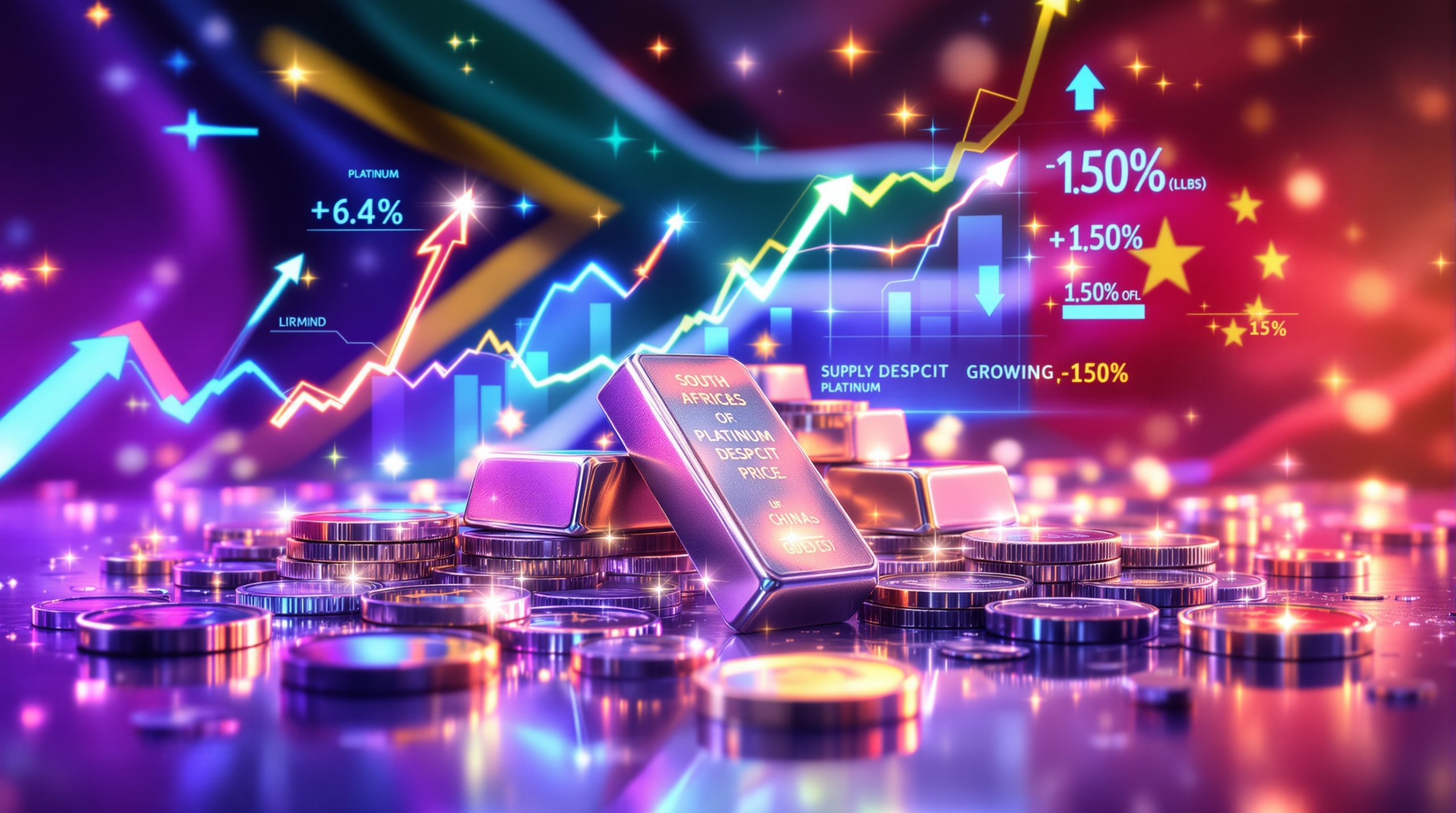Gold and Geopolitical Instability: Understanding the Complex Relationship
In times of global uncertainty, investors historically turn to assets that offer stability and preservation of value. Gold, with its millennia-long track record as a store of wealth, often takes center stage during periods of geopolitical tension. This precious metal's performance during conflicts, currency crises, and diplomatic standoffs reveals patterns that savvy investors can use to inform their strategies. The connection between gold and geopolitical instability continues to be a crucial factor for investors seeking to protect their wealth during uncertain times.
The Safe-Haven Effect: Why Investors Turn to Gold During Crises
When global tensions rise, financial markets typically experience heightened volatility. During these uncertain periods, gold's appeal as a safe-haven asset becomes particularly pronounced. Unlike currencies or stocks, gold maintains intrinsic value independent of any government's financial stability or corporate performance.
The flight-to-safety behavior observed during geopolitical crises creates predictable patterns in gold's price movements. As investors shift capital from more volatile assets, the increased demand naturally drives gold prices higher. This effect was dramatically demonstrated in 2024, when gold prices breached the $3,200/oz mark for the first time, delivering its strongest performance in more than a decade according to the "Gold 2025 – Breaking records" report. Recent record high analysis suggests this trend may continue as global uncertainties persist.
The Psychological Security of Tangible Assets
Gold's appeal during unstable periods extends beyond pure financial calculations. The psychological comfort of owning a physical, tangible asset that has maintained value through wars, depressions, and political upheavals provides investors with a sense of security that digital assets or paper currencies cannot match.
As the World Gold Council noted, gold's performance "reflects gold's diversified demand base – from jewellery and technology to bar and coin investment and central bank purchases – which helps to stabilize its role as an investment asset even as market conditions fluctuate."
Historical Price Patterns During Major Conflicts
Gold's price movements during historical conflicts reveal consistent patterns that inform investor strategy. When examining previous geopolitical tensions:
- Gulf War (1990-1991): Gold prices increased approximately 15% during the heightened uncertainty
- September 11 Attacks (2001): Gold saw a 5% jump in the immediate aftermath
- Iraq War (2003): The precious metal gained approximately 6% during the early phase of the conflict
- Crimea Annexation (2014): Gold prices rose 12% in the months following the escalation
- COVID-19 Pandemic (2020): While not a traditional conflict, the global health crisis created geopolitical tensions that helped drive gold to then-record highs
These historical precedents demonstrate gold's reliable tendency to appreciate during periods when global tensions escalate and uncertainty prevails. Understanding the market relationship guide between gold and other assets can help investors navigate these volatile periods.
Current Geopolitical Factors Driving Gold's Performance
Today's complex geopolitical landscape features multiple overlapping tensions that collectively influence gold prices. Regional conflicts have created ripple effects through global supply chains, disrupting economic stability far beyond conflict zones.
Regional Conflicts and Their Global Economic Impact
Modern conflicts create economic uncertainties that extend well beyond their geographic boundaries. Trade disruptions, sanctions regimes, and production stoppages all contribute to market instability that tends to benefit gold prices.
Recent years have seen gold breaking through previous resistance levels, with prices surging beyond $3,200 per ounce. This performance reflects investor preference for stability amid unpredictable global developments that threaten established economic patterns. Many analysts have updated their gold price forecast to account for these ongoing tensions.
The Dedollarization Trend
A significant factor influencing gold's recent performance is the gradual movement by some nations toward reducing dependence on the US dollar. This "dedollarization" trend has accelerated as geopolitical tensions have risen, with affected countries increasing gold reserves as an alternative to dollar-denominated assets.
Nations facing potential financial isolation have particular incentive to build gold reserves, as gold remains a universally accepted store of value that functions outside the traditional banking system when necessary. According to studies on geopolitical risks, this trend continues to support gold prices globally.
Supply Chain Vulnerabilities
Recent global events have exposed vulnerabilities in international supply chains, including those for gold itself. Mining operations face disruptions from regional conflicts, while refineries and transportation networks encounter obstacles during periods of heightened tension.
These supply constraints, occurring simultaneously with increased demand, create additional upward pressure on gold prices during periods of geopolitical instability.
Investment Strategies During Periods of Instability
Navigating the gold market during turbulent geopolitical periods requires strategic approaches tailored to different investor profiles and market conditions.
Portfolio Diversification Approaches
Financial advisors typically recommend gold as a portfolio diversification tool, with allocations varying based on:
- Risk tolerance: Conservative investors often allocate higher percentages to gold
- Investment horizon: Longer-term investors may weight gold more heavily during extended periods of tension
- Correlation benefits: Gold's tendency to move independently from stocks and bonds improves portfolio resilience
- Inflation expectations: Higher anticipated inflation typically warrants increased gold allocation
During periods of elevated geopolitical risk, many advisors suggest temporary increases to gold allocations as a protective measure against potential market shocks. The latest gold rally projections provide valuable context for these allocation decisions.
Gold Investment Vehicles: Comparing Options
Investors can gain exposure to gold through various vehicles, each offering different advantages during periods of instability:
| Investment Vehicle | Advantages During Instability | Potential Drawbacks |
|---|---|---|
| Physical Gold | Complete ownership, no counterparty risk | Storage costs, security concerns, limited liquidity |
| Gold ETFs | Liquidity, ease of trading, fractional ownership | Management fees, potential tracking errors |
| Gold Mining Stocks | Operational leverage to gold price, dividend potential | Company-specific risks, market volatility |
| Gold Futures | Trading flexibility, leverage opportunities | Complexity, expiration dates, margin requirements |
For those specifically concerned about severe geopolitical disruptions, physical gold stored in secure, accessible locations offers the highest degree of independence from financial system risks. However, many investors are exploring undervalued mining stocks as a way to gain additional leverage to rising gold prices.
Technical Analysis Considerations
Chart patterns provide valuable insights into gold's behavior during geopolitical events. Common technical formations during crisis periods include:
- Breakout patterns: Gold often breaks above long-term resistance levels during escalating tensions
- Volume spikes: Trading volume typically increases dramatically during initial crisis phases
- Volatility expansion: Price ranges widen significantly as uncertainty grows
- Support level testing: Previous resistance levels often become new support as prices advance
These technical indicators help investors identify potential entry and exit points as geopolitical situations evolve.
Gold's Relationship with Other Assets During Global Tensions
Gold's correlations with other asset classes shift significantly during periods of geopolitical instability, creating both challenges and opportunities for portfolio management.
Correlation Shifts with Traditional Safe Havens
During normal market conditions, gold maintains relatively predictable relationships with other assets. However, these correlations often change dramatically during geopolitical crises:
- US Treasury Bonds: Normally showing moderate negative correlation with gold, these assets often move in tandem during severe crises as investors seek multiple safe havens simultaneously
- Japanese Yen: The correlation typically strengthens from weak positive to strong positive during periods of global tension
- Swiss Franc: Already showing moderate positive correlation with gold, this relationship intensifies during instability
- US Dollar: The normally negative correlation becomes highly variable during crises, depending on whether the US is perceived as insulated from or central to the instability
Understanding these shifting relationships helps investors construct more resilient portfolios during unpredictable geopolitical episodes. Analysis of gold price volatility can provide additional insights into these correlation changes.
Commodity Market Interconnections
Gold's relationship with other commodities becomes particularly complex during geopolitical tensions. Energy markets especially demonstrate interesting correlations:
- Oil price spikes during Middle East tensions often precede gold rallies
- Agricultural commodity disruptions from regional conflicts can trigger inflation concerns that benefit gold
- Industrial metals sometimes move opposite to gold as economic slowdown fears impact demand expectations
These interconnections create ripple effects through commodity markets that savvy investors monitor for early signals of changing gold demand.
Mining Operations and Geopolitical Challenges
Gold mining companies face unique operational challenges during periods of geopolitical instability, particularly when operating in or near affected regions.
Security Challenges for Mining Companies
The security environment for gold mining operations deteriorates significantly during regional instability. In South Africa alone, illegal mining activities are "reportedly costing the industry billions of rands a year" according to recent industry reports. This "worsening security environment" places "significant pressure on operations" across the gold mining sector.
Mining companies must contend with:
- Increased risk of theft and illegal mining activities
- Higher security costs affecting operational profitability
- Potential for nationalization or changing regulatory environments
- Supply chain disruptions affecting production capabilities
These security challenges compound existing operational difficulties, creating complex risk management scenarios for mining executives.
Production Cost Pressures
Beyond security concerns, gold mining operations face additional cost pressures during geopolitical instability:
- Energy price volatility directly impacts operational expenses
- Currency fluctuations affect labor costs and equipment purchases
- Supply chain disruptions increase maintenance expenses
- Regulatory changes may impose new compliance costs
The South African gold mining sector specifically faces additional challenges including "rising electricity tariffs and the urgent need for mining companies to accelerate decarbonisation efforts," highlighting how regional factors compound global pressures.
Technological Adaptation in Mining Security
In response to heightened security threats, mining companies increasingly invest in advanced protective technologies:
- Drone surveillance systems for perimeter monitoring
- Biometric access controls for critical areas
- AI-powered predictive security systems
- Blockchain-based production tracking solutions
These technological solutions help mitigate security risks while potentially improving operational efficiency, creating long-term benefits that extend beyond the immediate crisis period.
Long-Term Implications of Sustained Geopolitical Tension
Extended periods of global instability create structural changes in gold markets that can persist long after specific tensions resolve.
Structural Market Evolution
Prolonged geopolitical uncertainty accelerates evolutionary changes in gold markets:
- Trading volumes increasingly shift toward Asian markets
- New pricing benchmarks emerge reflecting changed power dynamics
- Alternative settlement systems develop outside traditional channels
- Retail investor participation expands through digitization
These structural shifts create new market dynamics that persist even when specific tensions subside, permanently altering how gold trades globally.
Gold's Role in International Monetary Systems
As geopolitical tensions reshape international relations, gold's position within the global monetary system continues to evolve. Some emerging trends include:
- Increased central bank gold reserves as a percentage of total reserves
- Development of gold-backed digital currencies by various nations
- Consideration of partial gold backing for certain regional currencies
- Gold's use in bilateral trade settlement agreements outside the dollar system
These developments suggest a potential strengthening of gold's monetary role as geopolitical fragmentation challenges existing financial arrangements.
Technological Innovation in Gold Markets
Geopolitical pressures accelerate technological development in gold markets:
- Blockchain-based ownership verification systems enhance security
- Gold tokenization platforms increase accessibility and fractional ownership
- Quantum marking technologies improve supply chain transparency
- Advanced vaulting systems with biometric security protect physical assets
These innovations address specific challenges created by geopolitical instability while simultaneously modernizing an ancient asset class for contemporary investors.
Investment Preparation for Future Gold Price Movements
Preparing for gold's response to geopolitical developments requires both strategic planning and tactical flexibility.
Early Warning Indicators
Experienced gold investors monitor specific indicators that often precede price movements during geopolitical events:
- Unusual central bank gold purchase patterns
- Widening sovereign bond spreads in affected regions
- Increased volatility in currency markets
- Diplomatic communication shifts between major powers
- Sudden changes in cross-border capital flows
These indicators can provide early warning of changing market sentiment toward gold before price movements fully materialize.
Strategic Allocation Frameworks
Different investor profiles require tailored approaches to gold allocation during periods of uncertainty:
| Investor Type | Recommended Strategy | Allocation Considerations |
|---|---|---|
| Conservative | Physical gold and senior mining companies | Higher allocation (8-15%) with focus on capital preservation |
| Moderate | Mix of ETFs and select mining stocks | Balanced allocation (5-10%) with both growth and safety objectives |
| Aggressive | Junior miners and exploration companies | Targeted allocation (3-8%) seeking amplified returns through operational leverage |
| Institutional | Customized derivative strategies | Typically lower percentage allocation but larger absolute position sizes |
These frameworks provide starting points for developing personalized strategies based on individual risk tolerance and investment objectives.
Balancing Tactical and Strategic Positions
Successful gold investors distinguish between:
- Tactical positions: Shorter-term holdings responding to immediate geopolitical developments
- Strategic allocations: Long-term core positions providing portfolio insurance
This dual approach allows investors to maintain protection against unforeseen events while simultaneously capitalizing on specific geopolitical developments as they unfold.
Expert Forecasts Amid Ongoing Global Tensions
Industry analysts continue to revise their gold price projections as geopolitical factors evolve, with many seeing potential for sustained strength.
Current Price Projections
While specific price targets vary widely among analysts, several common themes emerge from expert forecasts:
- Expectations for continued price support from geopolitical factors
- Recognition of gold's technical strength after breaking previous resistance levels
- Acknowledgment of central bank purchasing as a persistent demand driver
- Consideration of inflation protection as a key component of gold's appeal
These factors collectively contribute to generally positive analyst sentiment toward gold prices in environments of persistent geopolitical tension.
Potential Market-Moving Scenarios
Analysts have identified several low-probability but high-impact scenarios that could dramatically affect gold prices:
- Sudden escalation of existing regional conflicts into broader confrontations
- Unexpected sovereign debt defaults triggered by geopolitical events
- Major cyberattacks on financial infrastructure
- Rapid shifts in military alliances or security arrangements
Prudent investors develop contingency plans for these unlikely but consequential scenarios.
Sustainability Considerations in Gold Production
The intersection of geopolitical concerns and environmental considerations is reshaping gold mining practices:
- Mining companies increasingly focus on reducing carbon footprints
- Renewable energy adoption at mining sites accelerates
- Water management improvements reduce environmental impacts
- Community relations receive greater attention to maintain social license
These sustainability initiatives respond to both regulatory pressures and investor expectations for responsible production practices.
Understanding Gold's Response to Different Types of Crises
Gold responds differently depending on the nature and scope of geopolitical events, with timing and magnitude varying significantly.
Response Timeline Variations
Gold markets typically react to geopolitical developments according to predictable temporal patterns:
- Immediate response: Price jumps often occur within hours of unexpected developments
- Secondary effects: Additional appreciation frequently continues for days or weeks
- Long-term adjustments: Structural price support may persist for months or years if tensions remain elevated
Understanding these timeline variations helps investors distinguish between temporary price spikes and sustainable trend changes.
Crisis-Specific Response Patterns
Different types of geopolitical events trigger distinct gold price behaviors:
- Regional conflicts typically cause moderate, sustained price increases
- Global financial system threats often trigger sharp, dramatic rallies
- Trade disputes generally create gradual upward pressure
- Political instability in major economies can cause volatile price action with multiple reversals
Recognizing these patterns helps investors calibrate their response to specific types of geopolitical developments.
Digital Alternatives Versus Traditional Gold
While cryptocurrencies are sometimes positioned as "digital gold," their performance during geopolitical crises has proven inconsistent:
- Bitcoin and other cryptocurrencies often display higher volatility than gold during crises
- Digital assets may face accessibility challenges during severe disruptions
- Regulatory risks for cryptocurrencies can increase during geopolitical tensions
- Physical gold continues to demonstrate more consistent safe-haven behavior
These performance differences highlight gold's enduring advantages during periods of geopolitical instability, even as digital alternatives continue to evolve.
Conclusion: Gold's Enduring Role in Uncertain Times
Gold's relationship with geopolitical instability reveals consistent patterns that inform investment strategy. While specific price movements remain unpredictable, gold's general tendency to strengthen during periods of tension reflects its fundamental role as a store of value when conventional assets face heightened uncertainty.
For investors navigating today's complex geopolitical landscape, gold offers both historical precedent and contemporary relevance. Whether held as physical bullion, mining shares, or exchange-traded products, gold's place in a diversified portfolio becomes particularly valuable during times when global tensions rise and market volatility increases.
By understanding gold's unique relationship with geopolitical instability, investors can make more informed decisions about how to incorporate this ancient asset into modern portfolio strategies designed to weather uncertain times.
Want to Be Alerted to the Next Major Gold Discovery?
Discovery Alert's proprietary Discovery IQ model instantly identifies significant ASX mineral discoveries, turning complex gold data into actionable investment insights. Explore how historic gold discoveries have generated substantial returns by visiting our dedicated discoveries page and begin your 30-day free trial today.




